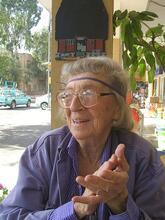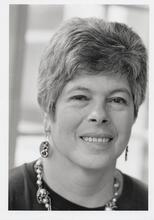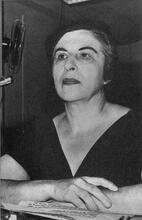Diane Noomin
Diane Noomin was an acclaimed comics artist and editor and creator of her alter ego, the glamorous and bouffant DiDi Glitz. She was a central figure in women’s comics beginning in the early feminist publications of the 1970s. From “Red Diaper Baby” (2003), in which Noomin reflected on her parents’ Communist views and activities, through her comics on abortion, female masturbation, abusive relationships, and miscarriages, to her last edited volume, the multi-award-winning anthology Drawing Power: Women's Stories of Sexual Violence, Harassment, and Survival (2019), Noomin fearlessly championed feminism and autobiography with “humor [that is] self-deprecating and ironic.”
“Coming of Age in Canarsie” and Early Politicized Experiences
Diane Noomin was born in 1947 in Brooklyn, New York. She studied at JFK Junior High where her artistic talent was recognized and her teachers encouraged her to apply to the High School of Music & Art, a special high school for the arts. Later she studied at the Pratt Institute, New York, for her BA. She had one sister, Ronnie. Her mother worked at Sperry Gyroscope during World War II and the social security administration and her father worked on 47th Street, and they were both secretly active in the Communist Party.
Noomin learned later in life that her parents “could never have afforded their house in Long Island […] [T]he Communist Party helped pay for it, or bought it, […] my parents were laundering money for the Party” (Rudick, 2012). In “Red Diaper Baby,” Noomin uses multimedia, including photographs, a telegram, a Christmas card, and drawings, to uncover what she can about was really going on: “I wonder what circumstance called my mother to Washington DC on my first birthday?” (Noomin, 2011: 122).
Nooomin introduces us to her own lawbreaking childhood in “Coming of Age in Canarsie” (1989): she navigates “making out parties” and “learned to pretend I didn’t study, to roll up my skirts, wear white lipstick, hang out in bowling alleys and shoplift” (Noomin, 2011: 109). The artist expands on the latter activity in “From Jaw breakers to Lawbreaker,” recalling what she stole from her mother, father, relatives, neighbors, and Woolworth’s. Her sprees only stopped because her friend “got caught stealing a gold chain!!… She got sent to Juvenile Hall.… No way I’m ending up there!!” (Noomin, 2011: 116–119).
Wimmen’s Comix and DiDi Glitz
In her twenties, Noomin moved to San Francisco, where she started her comics career. She met Aline Kominsky-Crumb at a party in 1971, and they were friends ever since. When they first met they both felt alienated from their families and their peers, both had left behind failed marriages to nice Jewish boys, and both were to find love in lasting marriages to other cartoonists, Bill Griffith and Robert Crumb respectively.
Noomin’s own adult political leanings were decidedly feminist, and during the 1970s she was part of The Wimmen’s Comics Collective. However, this unity was short-lived, as Noomin recalled that “they were pushing […] in the name of feminism and political correctness […] a sort of self-aggrandizing and idealistic view of women as a super-race.” In contrast, she adds, “Aline and I […] decided, ‘Well, fuck you, we’ll do our own comic.’ […] We preferred to have our flaws and flaunt them” (Noomin, 2004).
In 1973 Noomin attended a Halloween party, in a costume consisting of a blonde wig and fishnet tights. This outift was the birth of her alter ego, DiDi Glitz: “DiDi is both an exorcism and a wallowing in my Canarsie ‘roots.’ She enthralls and repels me” (Noomin, 1992: 62). DiDi lives in a world of pointy boobs, beautiful clothes, and over-decorated houses, and Noomin loved drawing all the intricately designed pages. She admitted her collection of Home and Garden magazines from the 1940s and 1950s inspired many of the pages. Beyond this glitter, however, DiDi suffers great pain in her life, which she washes away with Valium, M&Ms, and Mai-Tais. Martha H. Kennedy writes: “DiDi’s overeating and weight struggles speak to many women’s preoccupations with body image […] [S]he stood out as both especially idiosyncratic and as a landmark figure” (Kennedy, 2018: 68). DiDi also balances, with varying success, mothering her daughter, Crystal, with her own intimate and professional needs. “MO-THER!! You forgot to pack my lunch today!” complains Crystal when DiDi is preoccupied with her own sexual desires, in “DiDi Has an Orgasm” (2011:36).
In 1980, DiDi grew off the page and onto the stage. Les Nickelettes, a woman’s theater group based in San Francisco, invited Noomin to work with them on a musical, I’d Rather Be Doing Something Else: The DiDi Glitz Story, with the show also touring to New York. The artist was shocked by the ephemerality of theater, as she was used to the longevity of print. Fortunately, she was able to use the words of a song, “Rubberware,” in Wimmen’s Commix No. 10, International Politically Incorrect Fetish Issue.
Comics have long offered a landscape filled with complicated psychological relationships between superheroes and their more human alter egos. It is not therefore surprising that DiDi Glitz/the real Diane incorporates a masked element: “I used to say I hid behind DiDi, […] a non-personal persona I could put on to mask very personal issues while keeping a safe distance” (Noomin, 2011: 12). Noomin describesd how “DiDi became the natural way to do things. I could do satire and use real-life situations and have DiDi experience them in her way, so that I’m one step removed. It took a long time for that to change” (Rudick, 2012). However, whereas Superman is never shown alongside Clark Kent, Diane (the drawn Noomin) and DiDi do share the page.
Throughout her years as a comics artist, Noomin’ fearlessly traced her experiences of fertility, miscarriage, and abortion. In “The C Word” (1990), a one-page comic, Noomin reflects on her choice to have an abortion when she was 22, in a “loveless marriage” and unsure who the father was. A moment in which she is at the Museum of Modern Art (NYC) looking at a painting becomes the catalyst for her to revisit her emotions after her “easy” abortion. She later cries at her drawing table, writing her thoughts in a poetic form, “cleaning house vacuumed life away” (Noomin, 2011: 13). In those three consecutive panels—the abortion panel, the painting, and then the artist in her study—Noomin takes her readers on an emotional journey that ends with her own creativity: “By placing this painting [at MOMA] at the structural center of her comic, immediately following her description of the abortion as ‘easy,’ Noomin insists that her readers accept the complexity of the abortion story” (Ludlow, 2019). The comic finishes with a picture of the artist in more recent times, at her drawing table, acknowledging how the bravery of her younger self paved the way for her current creativity. “I owe my life to her choice,” she says, as she draws DiDi.
DiDi again appears as a figure in Noomin’s fertility herstory, “Baby Talk: A Tale of 3 4 Miscarriages,” another genre-breaking narrative. With a title font formed of opened diaper pins—sharp and dangerous, surgical and threatening—and the lettering in the style of a bloody horror film, “Baby Talk” reflects how the pain of miscarriage can lead to dissociation, allowing the sufferer to escape from traumatic reality (see Leonard, 2013, and Lightman, 2013). The comic opens with Jimmy and Glenda, who is pregnant with their first child. On the third page there is a dramatic shift in the narrative: Glenda dreams of a miscarriage and then DiDi Glitz drags/births Diane, the artist, from behind the comic on to the page through a drawn ripped birth canal/hole in the page. “Are you gonna let cartoon yuppies cry cartoon tears over your dead babies?” she asks (Noomin, 2011: 92). The page has become a space of creativity and fertility, of birth and loss. Diane sits on the comic on her drawing table, her wavy hair becoming increasingly unkempt as the narrative progresses, in this unique visualization of trauma. Years later, Noomin seems to answer DiDi’s question about “cartoon tears”: “I made a timeline of my miscarriages over the years and used it as a springboard for the narrative—there were times when I had tears streaming down my face while drawing or writing the story” (Lightman, 2011).
Editing Twisted Sisters and Drawing Power
Throughout her career as a cartoonist Noomin enjoyed significant success as a multi-award-winning editor of women’s comics. Her beautifully presented edited volumes continued to make comics history through their choice of artists and subject matter. She explained her preferences: “My criteria for comics is not whether something is feminist or not, I never think in those terms. It’s whether I like the art, whether I think it’s funny, whether it moves me. It’s very personal. I have to like the art and the writing, and that’s sometimes hard to find” (Rudick, 2012). Earlier collections included some of the most significant women comics artists, including Dori Seda, Carol Tyler, Alison Bechdel, Carol Lay, and Roberta Gregory. In 1976, Diane Noomin and Aline Kominsky Crumb edited Twisted Sisters. In 1991 Noomin edited Twisted Sisters: A Collection of Bad Girl Art, followed by Twisted Sisters Comics and Twisted Sisters, Vol. 2: Drawing the Line. Through her publications, Noomin was responsible for bringing many cartoonists to the public eye for the first time: “I’m very proud of the Twisted Sisters anthologies… People said, ‘Where did you find all these great female cartoonists?’ Unfortunately, it’s largely been forgotten by a younger generation of women cartoonists” (Rudick, 2012).
In 2019, Noomin edited the critically acclaimed Drawing Power: Women’s Stories of Sexual Violence, Harassment, and Survival, which in 2020 was awarded the Susan Koppelman Award for Best Anthology, Multi-Authored, or Edited Book in Feminist Studies in Popular and American Culture, and in the same year the Eisner Award for Best Anthology. Featuring 60 artists, this collection was described in the New York Times as a “landmark collection, beautifully produced, [which] shines a light on a relentless, unwelcome aspect of women’s lives” (Chute, 2019). Noomin revealed her motivation behind the anthology: “The idea came to me after watching Trump brag of sexual assault […] I was so angry and had nowhere to put that anger. […] I decided in that moment to create a book about real women being exposed to sexual violence or threat by real men” (Mielke, 2019).
From the early women’s comics collectives to Drawing Power, a 2020 Eisner Award-winning collection, Diane Noomin continued to be a vital force in the world of comics, producing work and editing collections that are beautiful, political, culturally significant and, as she herself says, “painfully autobiographical” (Noomin, 2011: 9).
Diane Noomin died on September 1, 2022.
Selected Works by Diane Noomin
Noomin, Diane, ed. Drawing Power: Women’s Stories of Sexual Violence, Harassment, and Survival. New York: Abrams Books, 2019.
Noomin, Diane. Glitz-2-Go. Seattle: Fantagraphics, 2011.
Noomin, Diane. “Wimmin and Comix.” ImageText 1, no: 2 (2004) http://imagetext.english.ufl.edu/archives/v1_2/noomin/. Accessed June 1 2020.
Noomin, Diane, ed. Twisted Sisters: Drawing the Line. Northampton, Massachusetts: Kitchen Sink Press, 1995.
Noomin, Diane, ed. Twisted Sisters: A Collection of Bad Girl Art. London: Penguin, 1992.
Noomin, Diane and Aline Kominsky Crumb, ed. Twisted Sisters Comics. San Francisco: Last Gasp, 1976.
Amihay, Ofra. “Red Diapers, Pink Stories, Color Photography and Self-Outing in Jewish Women’s Comics.” Image and Narrative 16, no. 2 (2015).
http://www.imageandnarrative.be/index.php/imagenarrative/article/view/8…. Accessed May 2, 2020.
Chute, Hillary. “The Best Comics of 2019,” New York Times, December 17, 2019.
https://www.nytimes.com/2019/12/17/books/review/best-comics-of-the-year…. Accessed June 20, 2020.
Kennedy, Martha. Drawn to Purpose: American Women Illustrators and Cartoonists. Jackson, Mississippi: University Press of Mississippi, 2018.
Leonard, Joanne. “Fetal Attractions: ‘Baby Talk; A Tale of 3 4 Miscarriages’ and Joanne Leonard’s Journal of a Miscarriage.” In Graphic Details: Jewish Women’s Confessional Comics in Essays and Interviews, edited by Sarah Lightman, 79-97. Jefferson, North Carolina: McFarland, 2013.
Lightman, Sarah. “Is it a bird? Is it a plane? No, it's the real-life superheroine,” The Jewish Chronicle, December 22, 2011. https://www.thejc.com/culture/features/is-it-a-bird-is-it-a-plane-no-it…. Accessed June 15, 2020.
Lightman, Sarah. “‘Cartoon Tears’: Diane Noomin’s ‘Baby Talk: A Tale of 3 4 Miscarriages.’” In Trauma Narratives and Herstory, edited by Sonya Andermahr and Silvia Pellicer-Ortín, 204-222. London: Palgrave Macmillan, 2013.
Ludlow, Jeannie. “Graphic Abortion: The Grotesque in Diane Noomin's 1990s Abortion Comics.” Feminist Formations 31, no. 2 (2019): 118-204.
Mielke, James. “A Graphic Novel for the #MeToo Era. Editor Diane Noomin lit the spark that became Drawing Power.” https://create.adobe.com/2020/02/27/graphic-novel-me-too-era.html. Accessed June 20, 2020.
Rudick, Nicole. ‘“I Felt Like I Didn’t Have a Baby But At Least I’d Have a Book”: A Diane Noomin Interview.’ The Comics Journal, May 8, 2012. http://www.tcj.com/i-felt-like-i-didn’t-have-a-baby-but-at-least-i’d-have-a-book-a-diane-noomin-interview/2/. Accessed June 5, 2020.












